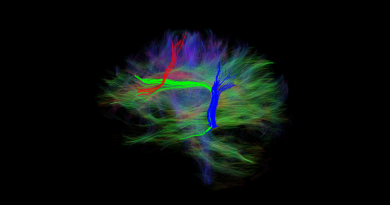A redundant modular network supports proper brain communication
Recall a phone number or directions just recited and your brain will be actively communicating across many regions. It is thought that working memory relies on interactions between these regions, but how these brain areas interact and properly represent memory has remained a mystery.

At Baylor College of Medicine, Dr. Nuo Li, assistant professor of neuroscience and a McNair Scholar, and his colleagues investigated the nature of the communication between brain regions involved in working memory and found evidence that a modular network organization is critical for persistent neural activity.

How brain regions interact
Li and his colleagues were able to see that each hemisphere of the brain has a separate representation of a memory. However, the hemispheres are tightly coordinated on a moment-to-moment basis, resulting in highly coherent information flow across them during working memory.
In their study, the researchers engaged mice in a simple behavior that would require them to store specific information. They were trained to delay an instructed action for a few seconds. This time delay gave researchers the chance to look at brain activity during the memory process.
“We saw many neurons simultaneously firing from both hemispheres of the cortex in a coordinated fashion. If activity went up in one region, the other region followed closely. We hypothesized that the interactions between brain hemispheres is what was responsible for this memory,” Li said.
Li and his colleagues recorded activity in each hemisphere, showing that each one made its own copy of information during the memory process. So how are the two hemispheres communicating?
Li explained that through the use of optogenetics they were able to corrupt information in a single hemisphere, affecting thousands of neurons during the memory period. What they found was unexpected.
When we disrupted one hemisphere, the other area turned off communication, basically preventing the corruption from spreading and affecting activity in other regions,” Li said. “This is similar to modern networks such as electricity grids. They are connected to allow for the flow of electricity but also monitor for faults, shutting down connections when necessary so the entire electrical grid doesn’t fail.”
In collaboration with Dr. Shaul Druckmann and Ph.D. student Byungwoo Kang at Stanford University, the researchers developed theoretical analyses and network simulations of this process, showing that this modular organization in the brain is critical for the robustness of persistent neural activity. This robustness could be responsible for the brain being able to withstand certain injuries, protecting cognitive function from distractions.
“Understanding redundant modular organization of the brain will be important for designing neural modulation and repair strategies that are compatible with the brain’s natural processing of information,” Li said.
Read the paper in the journal Cell.
Others who took part in the study include the lead author Guang Chen with Baylor and Jack Lindsey with Stanford University.
Funding for this study was supported by the NIH NINDS and BRAIN Initiative grants (NS112312, NS104781, NS113110, EB02871), the Simons Collaboration on the Global Brain and the Robert and Janice McNair Foundation. Further support was provided by the Whitehall Foundation, Alfred P. Sloan Foundation, Searle Scholars Program, Pew Scholars Program and McKnight Foundation.


